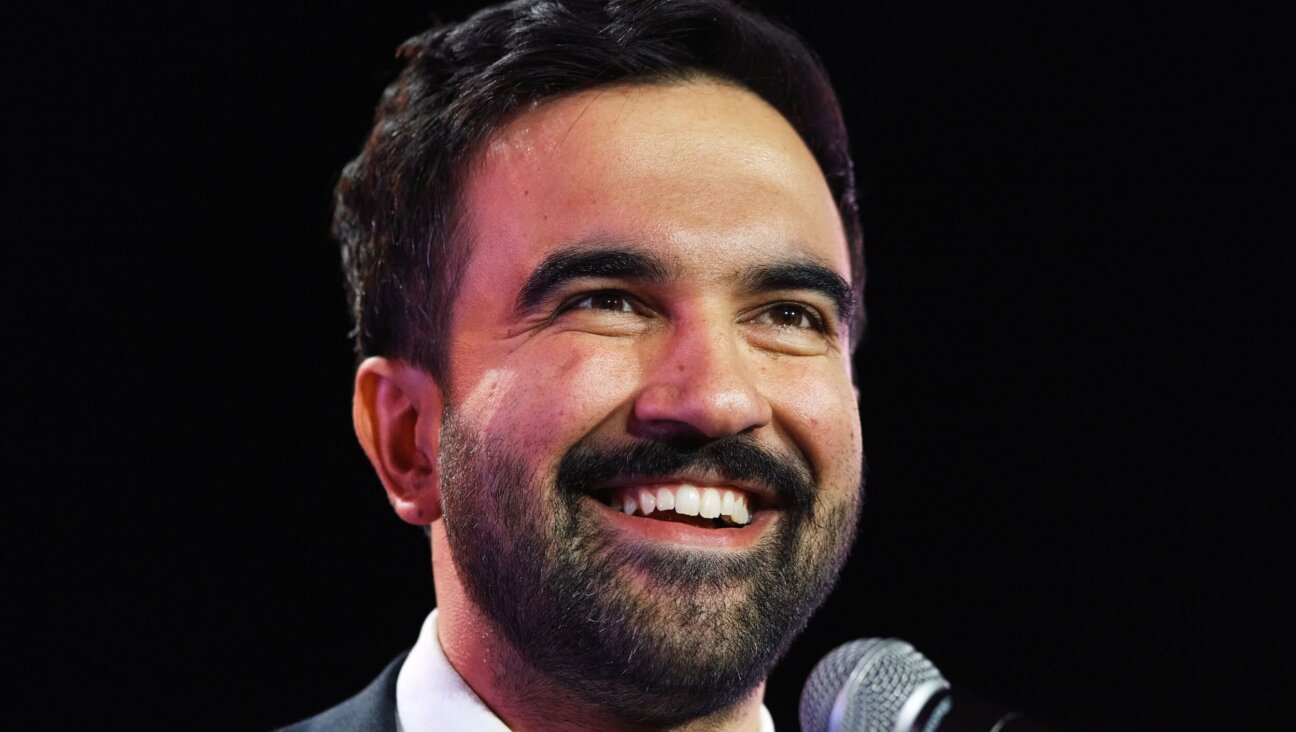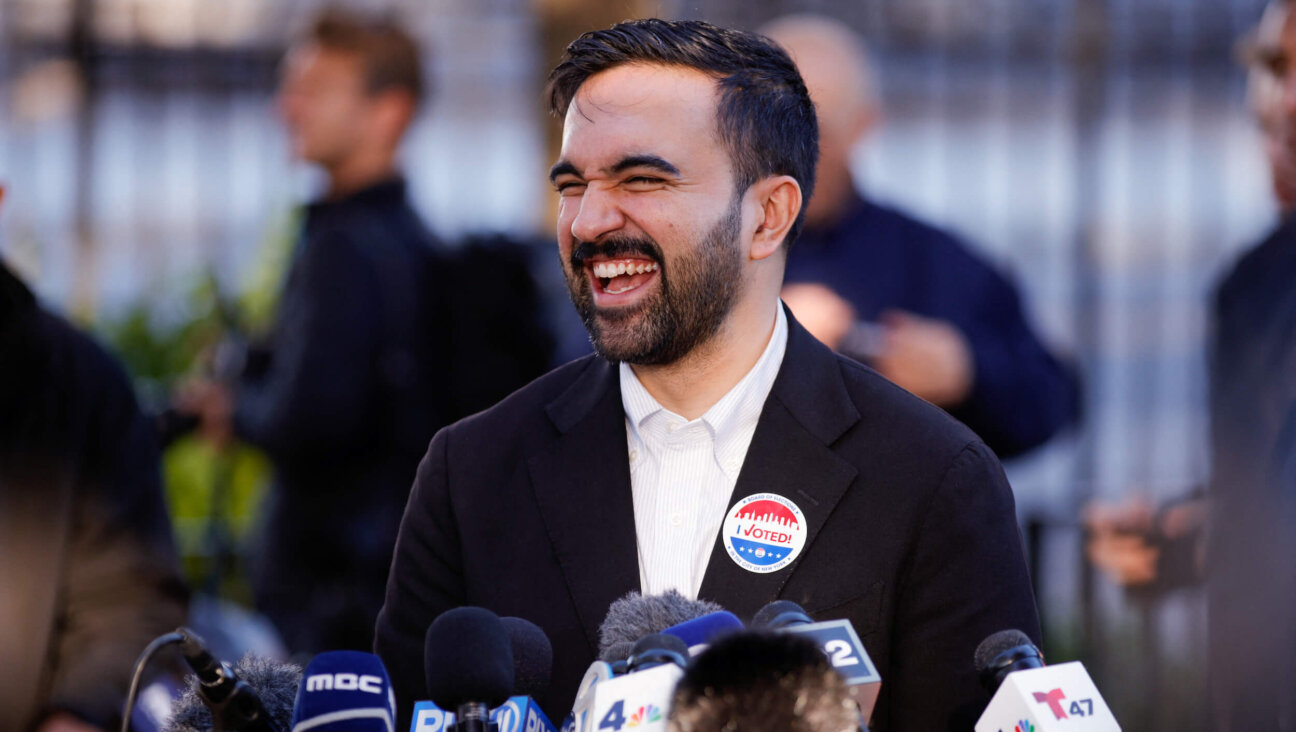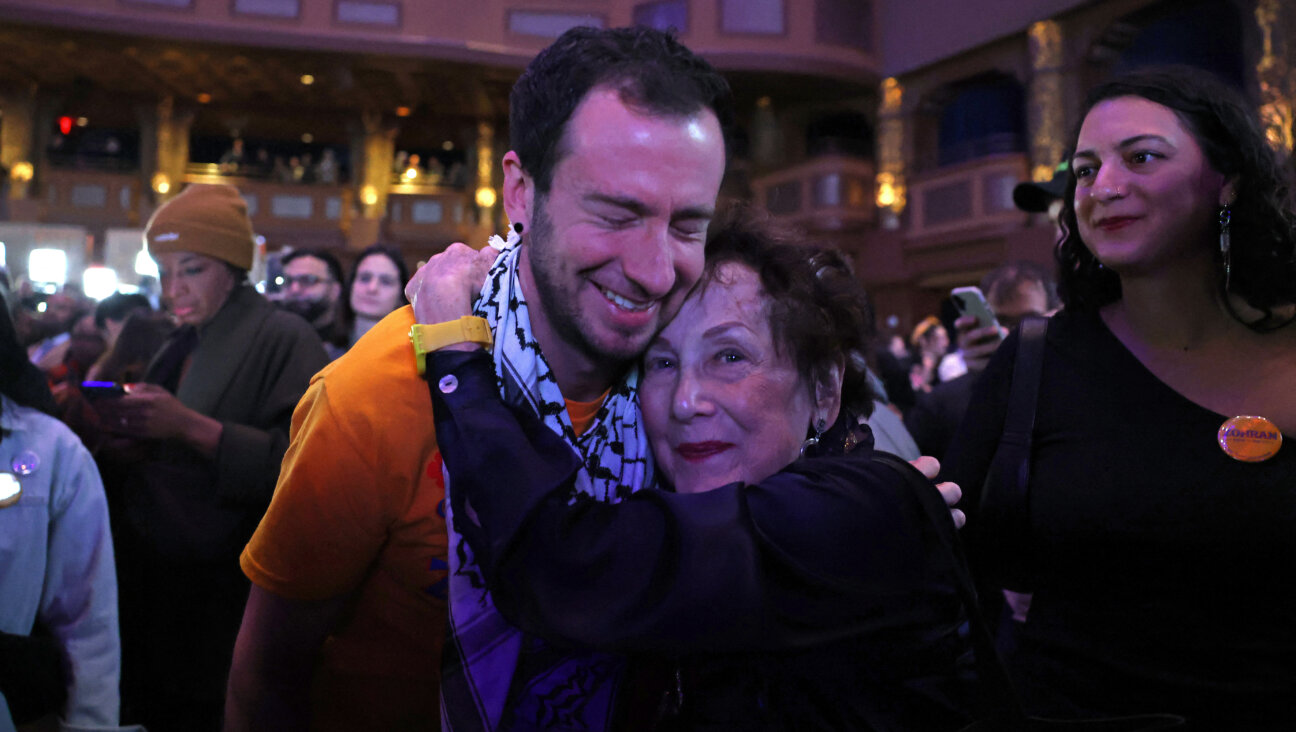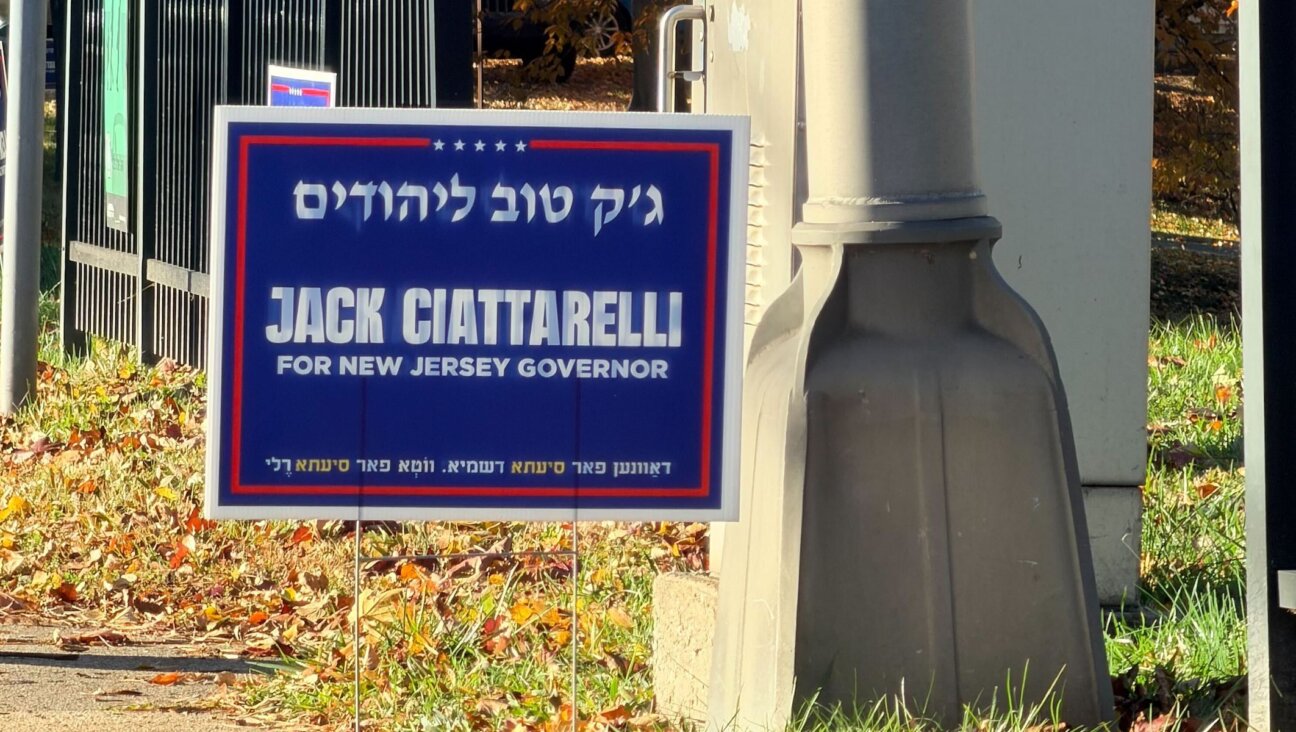Yehuda Glick Brings Extreme Vision of Temple Mount to the Knesset — With an Affable Touch
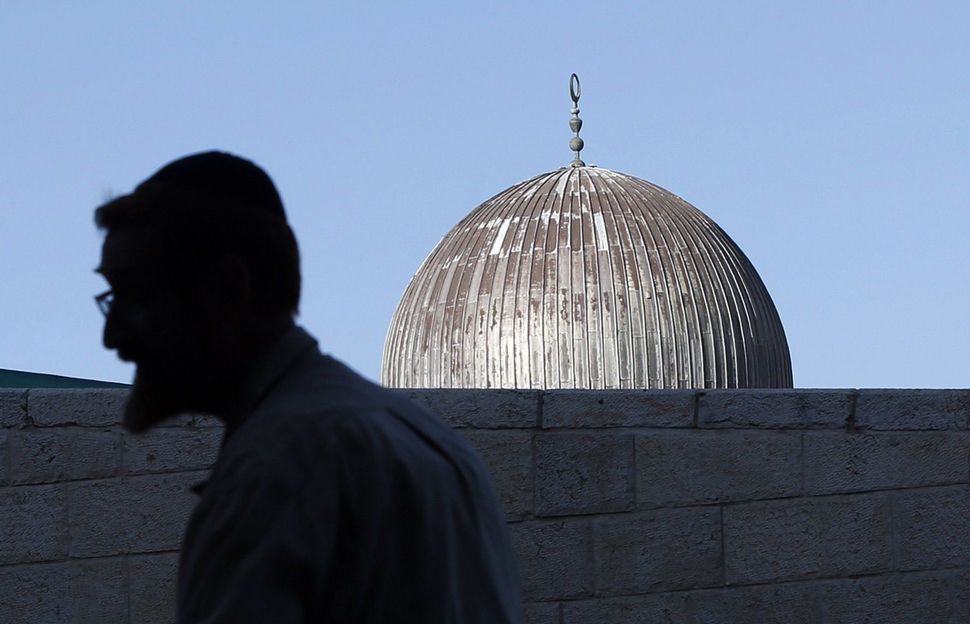
Image by Getty Images
On May 24, Israel’s parliament welcomed its first-ever member to survive an assassination attempt before he even stepped foot into office.
Yehuda Glick was shot and wounded for his leading role in groups devoted to rebuilding the Jewish Holy Temple in Jerusalem at a sensitive site sacred to Jews, Muslims and Christians worldwide.
In a secular body devoted to more conventional activities, like security and defense, social welfare and economic progress—not to mention the never-ending debate over Israel’s occupation of Palestinian lands—that kind of background might be expected to marginalize the newly minted, 50-year-old lawmaker.
But Glick, an affable grandfather of six with a bushy red beard and a rushed gait, does not come from some marginal religious faction. A member of the ruling Likud party, Glick stepped into his Knesset seat after the abrupt and acrimonious resignation of Defense Minister Moshe Ya’alon from the Israeli Cabinet in May. Ya’alon’s simultaneous departure from his Knesset seat suddenly made the Brooklyn-born Glick, who was next in line on the Likud party’s list of candidates, an Israeli lawmaker.

Narrow Escape: Glick was seriously wounded in October 2014 when a would-be assassin shot him four times. Image by Getty Images
For many, this shift exemplified the very trend that Ya’alon warned of in his angry, widely noted resignation speech. “To my great regret,” Ya’alon said then, “extremist and dangerous elements have overrun Israel as well as the Likud party, shaking up our home and threatening harm to those in it.”
But Ya’alon’s Knesset successor, it turns out, is no simple man to pigeonhole. Among other things, he strongly supported Ya’alon when the latter came under attack for condemning the Israeli Army medic who shot and killed a prone and wounded Palestinian assailant in Hebron in March, provoking an international outcry. Glick himself criticized the medic’s conduct in a written statement, even as many of his constituents justified the killing.
Still, Israeli police have reportedly singled out Glick as an extreme threat to the combustive status quo in Israel and the Palestinian Territories.
Sitting on a beige couch in his new basement-floor Knesset office — sparse but for a neon-hued panoramic photograph of the famous site where Glick hopes to see a rebuilt Temple — the new lawmaker said that there was no one more surprised than he to suddenly find himself in the Knesset.
“I didn’t have any plans to become a member of Knesset, it just happened to me, some kind of historical accident,” he said, still with a slight Brooklyn accent. “So I said, ‘God, you sent me here and I am taking upon myself the appointment, and I pray to you that you should accompany me every moment.’”
Glick owes his reputation as a radical to his leadership of a controversial movement for Jewish prayer at Jerusalem’s Holy Esplanade. To Jews, this sacred site is known as the Temple Mount. For Jewish believers it’s the spot where Abraham was set to sacrifice his son Isaac at God’s command, until God stopped him. It’s the site, they believe, where King Solomon’s first Temple stood and was later rebuilt, and it’s where the Third Temple will be built with the coming of the Messiah—or, perhaps earlier, if Glick and his supporters have their way. To Muslims this same space is the Noble Sanctuary, or Haram al-Sharif, the spot visited by the Prophet Muhammad on his night journey to Jerusalem, and from which he ascended to heaven on Buraq, a glorious white steed.
After the 1967 Six Day War, when Israel’s military seized the Temple Mount, Moshe Dayan, who then was the Israeli chief of staff, laid down the policy that Glick now challenges: Muslim religious authorities would retain exclusive control of the Temple Mount, as they had since 637, save for a period during the Crusades. For Israel it was a pragmatic way to show Arabs and the larger Muslim world that its conquest was not a religious one, and to avoid igniting a larger conflagration.
Since then, only Muslims have been allowed to pray at the Holy Esplanade, the site of the Al Aqsa mosque. Israel’s chief rabbis and most Orthodox authorities support the ban out of concern that Jews who ascend the Temple Mount could unknowingly trample on the holiest spots on the site.
Israeli police, meanwhile, maintain this rule for security reasons, believing that Jewish prayer foments Palestinian fears of a Jewish takeover of the Temple Mount — and could lead to a violent eruption that could spread across the Middle East. Indeed, many of the Palestinian attacks against Israelis since October can be traced to tensions over the Holy Esplanade.
Now, some Jewish Israelis, led by Glick, are protesting this prohibition.
Glick is “playing with fire,” said Yedidia Stern, head of the religion and state project at the Israel Democracy Institute. “He is putting a match next to a huge amount of TNT and hoping nothing will happen. A little mistake can change the whole geopolitical situation in the area.”
In 2014, Glick learned firsthand the deadly consequences of his game when an alleged member of the terrorist group Islamic Jihad shot him point-blank four times in the stomach. “I’m very sorry, but you’re an enemy of Al Aqsa,” his assailant reportedly said to him. “I have to.” Since then, Glick has carried a Glock pistol at all times. Upon entering the Knesset, he was assigned an armed guard.
It was after Glick recovered from his gun wound, albeit with half a lung and part of his stomach missing, that he was elected to the Likud party. At number 33 on the Likud list, it seemed unlikely then that he would ever make it into the Knesset.
Ironically, Glick’s entrance into Israel’s parliament now means that he can no longer ascend the Temple Mount. Prime Minister Benjamin Netanyahu banned Knesset Members from the site — Jews and Arabs alike — to calm tensions. Glick had been barred from the site several times previously, including, after he was charged, with having pushed an Arab woman there, who broke her arm during the fall. A Jerusalem court later cleared Glick of wrongdoing.

His Debut: Yehuda Glick gives his maiden speech before the Knesset on May 25, after his surprise ascent to the lawmaking body. Image by Getty Images
Glick visited the Temple Mount for the last time — at least for now — hours before he was sworn in in May. Later that same day, at a meeting with Netanyahu, the prime minister chided Glick. “That is the last time you do that to me,” the new lawmaker recalled being told. “From now on, you are a soldier” for the Likud, Netanyahu said.
As a Knesset member, Glick has also had to give up his role as the director of the Temple Mount Heritage Foundation, the not-for-profit organization he founded that is an umbrella group for other Temple Mount advocacy groups.
But Glick wasn’t worried about his new constraints: “I was not involved in a movement trying to promote the ability of Yehuda Glick to go up to the Temple Mount,” he said. “I was involved in a movement which was getting more and more Jews and non-Muslims to go on the Temple Mount, and I am continuing from here.”
Glick said that in the Knesset, his office will be known as the “office of Jerusalem of peace,” from which he will advocate for interfaith dialogue between Jews and non-Jews. Glick often speaks highly of Muslims, noting that a devout Muslim doctor saved his life after another Muslim tried to end it.
But Glick’s vision of peace is coexistence under Jewish control. Palestinians, he said, have “missed the train” for their own state. He instead advocates subsuming the occupied West Bank — where he lives with his wife and children in the Jewish settlement of Otniel — into Israel. In this vision, West Bank Palestinians would become citizens of Jewish Israel, gaining the right to serve in the Israeli Knesset but ceding their hopes for independence.
His proposal, he said, does not include Gaza and its 1.5 million Palestinians “at this time.” This would enable his expanded version of Israel to maintain a Jewish majority, albeit a smaller one — about 63% of the population compared to almost 75% now. Moreover, Israel would pay Palestinians to emigrate, he added, abetting a quiet outflow of the West Bank’s Arab population that he claimed was already taking place. “The project in [J]udea and Samaria will be gradual,” his spokesman wrote in an email, using biblical names for the West Bank region, and in addition, “Only those who are not part of any terrorist activity for 10 years will receive citizenship.”
Glick was vague on just how he would continue to advocate for Jewish prayer on the Temple Mount during his Knesset tenure. In any event, if he were to advance legislation on that issue, Netanyahu would likely block it, said Tomer Persico, a fellow at the Shalom Hartman Institute. “The prime minister right now doesn’t want any of that coming on the table and becoming a subject of discussion.”
Even so, Glick’s Knesset seat now gives him a bigger platform from which to spread his ideas about Jewish prayer on the Temple Mount. Once thought of as the domain of right-wing nationalists, the Temple Mount prayer issue has evolved under Glick into a cause wrapped in the mantle of civil rights. In Glick’s discourse, Jews and Muslims deserve the chance to worship equally on the site. By framing his immediate goal as one of equal prayer, a seemingly liberal concept, Glick has widened the appeal of what was once a fringe movement.
Observers say that Glick’s focus on civil rights isn’t just an act to win over Temple Mount skeptics. He has taken some surprisingly liberal positions in recent months. Besides criticizing the army medic’s killing of the wounded Palestinian in Hebron, Glick has spoken warmly of Reform and Conservative Jews — even as he has denigrated the Western Wall just outside the Temple Mount, where these groups are fighting with more traditionalist Jews for equal prayer rights. Glick views that site as a poor substitute for the spirituality of the Temple Mount itself.
Glick is a “combination of nationalist and liberal,” said Yair Sheleg, another religion and state expert at Israel Democracy Institute.
But Glick’s emphasis on equal prayer must be viewed in the context of the broader Temple Mount movement. For many years, that movement has asserted its goal plainly: erecting a third Jewish Temple atop the Temple Mount, one that would replace at least some of the Muslim structures there. It’s a goal that just got a boost from Israel’s chief rabbi, David Lau, who said on Israeli television that a Jewish temple could be built atop the site without damaging Muslim shrines. (It’s unclear how his opinion squares with his ban on Jewish prayer there.)
Some observers view Glick’s fight for equal prayer as strategic: Once enough Israeli Jews sign on, it will be more difficult for the government to block efforts to build the Third Temple.
Glick does not disavow his movement’s long-standing goal. Asked how equal prayer relates to bringing about the Third Temple, he said that he is “ready to promote that step.” He called the Third Temple a “house of prayer for all nations.” At the same time, he was vague about what Muslim structures could remain when the Third Temple was constructed. Perhaps the Al Aqsa mosque could stay in place, he suggested, but “maybe the Dome of the Rock” — one of the structures most sacred to Muslims — “will become part of the next temple.”
“[Glick] believes that if Jews are able to pray there, they will want to, and from a situation of today, where you have several dozen Jews wanting to go there, you will maybe have hundreds daily and on holidays thousands. They will have a spiritual experience, and there will be lots of excitement and attraction,” said Aviv Tatarsky, a researcher at the Ir Amim organization, which has been critical of the Temple Mount movement. “You can go to this next step [of building the Third Temple.] So it is not some mystical or religious belief. It is very political.”
Glick’s penchant for keeping company with some of the Temple Mount movement’s most violent leaders does not help allay such concerns. He counts as a close ally Yehuda Etzion, who was jailed for five years for a plot to blow up the Dome of the Rock. Glick said he is glad that Etzion didn’t succeed in his efforts, but he called his friend a “dreamer” who “wants to see a better world.”
Glick warned that if Muslims object to Jewish prayer on the Temple Mount, they could risk it all. “I am afraid, unfortunately, that the Muslims, with their objections to any kind of Jewish visits to the Temple Mount, are going to cause damage,” he said. “If they are going to try to promote war on the Temple Mount, I’m not sure if they know the consequences of that.”
While Tatarsky disagrees with Glick’s ideology, he has no qualms with the man personally. He’s a “charismatic and funny person with a very friendly personality,” said Tatarsky, who has met Glick on several occasions. Indeed, Glick’s charm has contributed to the success of his movement. And apparently it’s genuine.
Glick spent the first nine years of his life in the Flatbush neighborhood of Brooklyn, before his parents uprooted their family of eight to Beersheba, where Glick’s father, Shimon Glick, was recruited to help open Ben-Gurion University’s new medical school. The senior Glick later became a leader in Meimad, a now-defunct Modern Orthodox political party that supported territorial compromise for peace in the West Bank and Gaza.
Brenda Glick, Glick’s 83-year-old mother, described her son as so generous as a child that his teachers called her to tell him he was giving away his belongings to the other students.
Of all her children, Glick had the hardest time adjusting to his new life in Israel. Short and smart, he was bullied by other students in his elementary school, but he never told his parents. Glick went on to study at yeshivas in Jerusalem and in West Bank Jewish settlements. He was part of a special army program for Orthodox soldiers, where he served in a tank battalion and studied in yeshiva.
Glick was as a yeshiva student in the 1980s when he became interested in the Temple Mount. He read everything he could get his hands on about the topic. Eventually, he decided that he sided with the minority of rabbis who held that it was permitted for Jews to ascend to the site under traditional religious law. His first visit, in 1989, was spiritually unremarkable, he said. But every visit since then has left a powerful impression on Glick.
“When you are going up to the Temple Mount, you understand you are the only Jew here today,” he said, “meaning you are representing tens of centuries of Jews who have wanted to be here. You feel it on your shoulders.”

Temple Minded: Likud MK Yehuda Glick has championed the rights of Jews to pray on the Temple Mount, where the Dome of the Rock mosque stands. Image by Getty Images, Montage: Kurt Hoffman
At the same time, Glick was becoming an activist in the movement to free Soviet Jewry. It was through this activism that he met Yuli Edelstein, a Soviet dissident who would later become a Likud member of Parliament and, eventually, the speaker of the Knesset. Edelstein hired Glick as the spokesman for the Ministry of Immigrant Absorption for the southern district, where Glick represented towns on the southern border near Gaza. But in 2005, when Israel evacuated Jewish settlements from Gaza, Glick quit his post in protest. The Gaza disengagement, he explained, “was breaking the people, tearing the nation” apart.
The disengagement also sparked a political change in the Likud, from which Glick would later benefit. As Israel pulled out of Gaza under a right-wing government, many settlers saw that they were powerless to change policy, even if their politicians were part of the governing coalition. “What they understood from that is that if you want real influence, you should not just be satisfied being part of the coalition,” Sheleg said. “You should influence the Likud party itself.” Glick’s ascendance marked the latest step in this effort to supplant the party’s long-standing secular hard-line leadership with religious nationalists.
After Glick left his government position following the disengagement, he was offered a job as director of the state-funded Temple Institute, where he began to formally work for Jewish prayer access to the Temple Mount. He quickly became the most effective spokesman on the topic.
“He succeeded in bringing this subject to a national discussion,” said Yaacov Hayman, another Temple Mount activist. “Many, many more people have become in favor of it than in the past.”
Glick himself noted with pride: “We reached a point that this Passover we had a record of more than 1,000 Jews who visited the Temple Mount in five days. Then, on Jerusalem Day, we had more than 300 Jews in one day. It wasn’t like that in the past.”
Glick’s parents don’t share his passion for the Temple Mount, or his politics, for that matter. Brenda Glick said that the couple has not ascended the Temple Mount out of deference to rabbinic authorities who prohibit the act. Of the couple’s six children, three of them, Glick included, are now Orthodox nationalist settlers.
“We did belong to political groups that felt that peace was more important than land. But we came from different backgrounds,” Brenda Glick said. “We weren’t exposed to the things that they were exposed to.”
Brenda Glick worries that her son’s activism could cost him his life like it almost did in 2014, especially now that he is a member of the Knesset. “No mother wants their children in dangerous positions no matter how idealistic they are,” she said. She likened observing her son’s efforts on the Temple Mount to being the audience in the play of his life. “I can cry and laugh and clap,” she said. “I can’t stop him.”
Contact Naomi Zeveloff at [email protected] or on Twitter, @NaomiZeveloff









